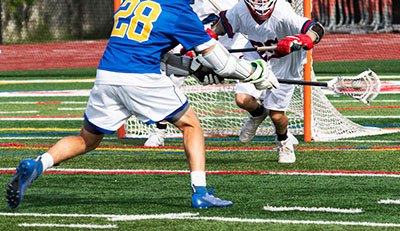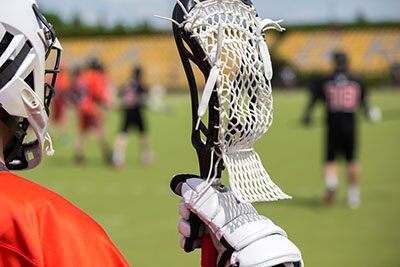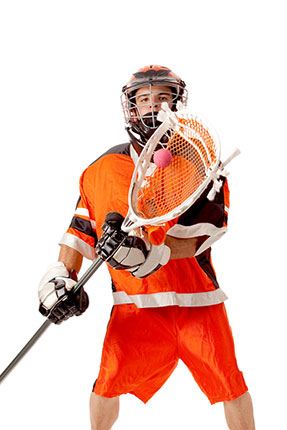If you're a lacrosse player looking for the latest updates on lacrosse illegal stick crosse penalty regulations, this guide is perfect for you.
Dive in now and stay up-to-date with all the legalities surrounding an illegal stick in lacrosse. Let's start!
More...
Take away key points:
Boys' lacrosse rules are very specific regarding the lacrosse stick and an illegal lacrosse stick.
Read below to find out what factors affect the legality or illegality of the stick and what the officials can do with illegal lacrosse sticks.
Determining the legality or illegality of lacrosse stick
Lacrosse sticks are critical parts of lacrosse equipment, but they must undergo the required specifications regarding the way player's stick measurements, construction, and depth.
Referees and other officials can examine any player's stick during the game, mainly during the time-outs, between the quarters, and after goals. A player who does not comply with the stick checks can suffer an illegal stick penalty.

What is an illegal stick penalty in lacrosse?
In lacrosse, an illegal stick penalty generally occurs when a player's stick does not meet the legal standards set by the governing body. This includes:
- Sticks that are measured as having a head that is too wide or too deep
- Shafts and heads with illegal angles
- Sticks that have been altered in any way, such as having extra holes drilled into the sides of the head
llegal sticks increase the risk of injury to players due to their increased potential for causing accidental damage. Defensive players can also be disadvantaged if they have illegal sticks on offense and suddenly cannot use them defensively.
While it may seem like a minor rule violation, breaking this regulation can leave your team vulnerable and cause severe problems during play. Therefore, it is crucial for players to always stay up to date with current rules regarding their gear so that an illegal stick penalty never causes problems during a game.
When are lacrosse head and the stick illegal?
There are four categories the lacrosse head and stick, in general, must satisfy: length, lacrosse pocket depth, lacrosse ball retainment rules and other lacrosse rules & specifications.
1. Length
Length is the basic lacrosse stick rule, and all lacrosse sticks must measure between 40-42 inches and 52-72 inches. Any discrepancy between the allowed length during the stick check will result in an illegal stick penalty for a lacrosse player.
The lacrosse head is also prone to checking, as it must comply with specific standards. Thus, the lacrosse head must measure at least 6.5 inches at the scoop, three inches at the lowest point of the lacrosse head, five inches at the midline, and the entire length of the lacrosse head from the top to the endpoint must be ten inches.
Shaft angle is another requirement to make the stick legal and follow the specific rules during the stick check.
Finally, the officials will conduct the so-called table test. Once they lay a lacrosse stick down on the table, the overall distance from the tabletop to the bottom of the lacrosse stick must not exceed 2.75 inches. If the table test shows more than these dimensions, the lacrosse stick is deemed illegal, and the offensive player is penalized.
2. Lacrosse pocket
In addition, the lacrosse pocket legality must be of the proper depth in the lacrosse head. Penalties are often called as players don't respect the allowed pocket depth. Thus, the illegal deep pocket will penalize the offending player.
The lacrosse sticks will be legal when the upper edge of the ball is obscured by the sidewall strings holding the mesh. However, the stick is illegal if the ball sinks inside the deep pocket beyond the sidewall string and the ball is in full view.
The stick is illegal if the players add additional strings - a pull string, for instance, to pull strings and make the pocket shallower. Thus, they can try to cover the deep pocket and an illegal lacrosse head.
The shooting strings are another factor in making your stick considered illegal or legal. The shooting strings must be within four inches of the top of the scoop on the lacrosse head. Other rule-breaking methods include the deceptive multicolored mesh, more than two sidewall strings, or long-hanging strings.
3. Ball retainment rules
A lacrosse stick must follow the ball retainment rules. The first test to check such standards is the forward tilt test when the stick is slightly tilted forward and the ball is placed in the pocket. The stick is legal if the ball pops out of the pocket before the lacrosse head is parallel with the ground.
There are two types of the title test to ensure the legal stick in lacrosse: lateral tilt test and perpendicular tilt test. The lateral tilt test is performed when the stick is held horizontally and rotated, allowing the ball to fall out from the side of the pocket. The perpendicular tilt test involves placing the ball in the deepest part of the pocket. Next, you must tilt the head of the stick down until it's perpendicular. The stick is legal if the lacrosse ball rolls out before the stick reaches a ninety-degree angle.
4. Additional standards
Other specifications include:
- Sawing the bottom of the throat of lacrosse heads and allowing more leverage
- No ball stop for wooden lacrosse heads (a plastic scoop does not require a ball stop, but a wooden lacrosse head does
- No manufactured end cap at the bottom of the lacrosse shaft
- Prohibiting tape at the throat of the lacrosse heads
When is a goalie stick deemed illegal?
The men's lacrosse goalie stick must be 40-72 inches when measured from the bottom of the stick to the top of the head. Boy's lacrosse rules for U-9 and U-11 have different requirements, with a lacrosse shaft between 37 and 72 inches.
In addition, the lacrosse head must measure between ten and twelve inches at the widest point. Sidewalls must not be bigger than two inches. Measured from top to bottom, the goalie's head must not exceed 16.5 inches. If the goalie stick does not comply with the given standards, the goalie stick is considered illegal.

Is an illegal stick a technical foul or a personal foul?
Any time an illegal stick is used on the field, it's considered a personal foul - meaning the player who used that stick gets penalized. Illegal sticks often infringe on field safety due to the wider head angle or longer length of the shaft than allowed.
If a dangerous play occurs with an illegal stick, that player could seriously injure another. Therefore, it is essential for everyone playing lacrosse to understand that not only is it unsportsmanlike conduct, but dangerous and illegal as well.
What's the punishment for the illegal stick?
The punishment for illegal crosse in the NCAA rules requires a one-to-three-minute penalty. In addition, the punishment is a non-releasable penalty.
The non-releasable penalty differs from a releasable one, where a player can return to the game if the opposing team scores a goal during the penalty time. The non-releasable penalty does not allow a player to return to the play until the serving time is over.
If the illegal crosse has an illegal pocket, the penalty is one minute in the penalty box, and after fixation, the crosse can be used again in the play. Any other violation of the rules results in a three-minute serving time, and the illegal crosse cannot be used in further active play.
In youth lacrosse, the penalty for illegal crosse is two minutes out, and the errors can be corrected to allow the stick in a more active play.
Sticks without an end cap or with illegal hanging string length can be corrected without receiving any penalty. However, the players will be penalized if they use the sticks even after the warning without corrections.
What is the main signal for illegal sticks?
In both youth and NCAA lacrosse, the referee will hold up the stick and bend his elbow across his chest. Then, he will point at the stick with his index finger to indicate the illegal stick. The same signal serves for any other illegal gear penalty.
Examples of illegal sticks
Here are some of the most common examples of illegal sticks for a better understanding:
- A player has scored a goal, but before the official blows another whistle, it's determined that he used an illegal crosse. The crosse has a deep pocket and a pull string to cover the illegality. As a result, the goal is nullified, and the player receives a one-minute non-releasable penalty.
- During a game, an official learns that a stick is less than forty inches long. As a result, the crosse is removed from the play, and the player receives a three-minute non-releasable penalty.
- While examining the stick the officials determined the ball would not roll freely by conducting tilt and perpendicular tests. As a result, the player receives a three-minute non-releasable penalty, and the stick is removed from the play.
Similar penalties to illegal crosse
As illegal sticks are personal fouls, let's see other similar penalties resulting in stricter punishments for the players. Some of them include: withholding the ball from play, illegal procedure, illegal equipment.
Withholding the ball from play
Withholding the ball from play includes an action in which a loose ball is on the ground.
A player must not trap the ball with a stick longer than necessary to control it and pick it up with one continual movement, lie on the ball, or withhold the ball from play in any other manner.
Illegal procedure
Illegal procedure refers to the use of illegal equipment, delay of play, touching of the ball by a player other than the goalie, avoidable lateness of the team, playing in the game without a stick, placing a stick in an opponent's face, more than ten players on the field at a given time, entering the game before the expiration of a penalty, and other illegal methods.
Illegal equipment
Illegal equipment includes a stick that is too long or short, a deep pocket, illegal strings, wearing illegal gloves or uniforms, refusing to wear the equipment and gloves or altering them, alteration of helmets, pads, etc.

FAQs
What is a cross check in lacrosse?
Cross checking in lacrosse is when a player uses the neck of their stick to make contact with an opposing player. It can be considered either a minor or major penalty depending upon the severity of the cross check. This type of contact is not allowed and could result in both fines and suspension for those who choose to partake in it.
Why do refs check lacrosse sticks?
The refs check the sticks to ensure the players are safely and adequately equipped, and the sticks do not provide any advantage or disadvantage to any player.
Summary
As you can see, the lacrosse illegal stick crosse penalty is a personal foul, followed by a non-releasable penalty for a player committing the offense.
Players should avoid such penalties to ensure their team performs better during the play and take the game to the next level.
Besides, the legal equipment provides maximum safety and protection on the field, so do not disobey the standards.
